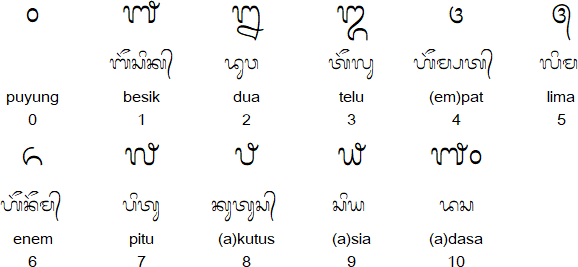Balinese 
Origin
The Balinese alphabet or Carakan descended ultimately from the
from Brahmi script of ancient India by way of the
Pallava and Old Kawi scripts. The oldest known inscriptions in the Balinese
alphabet date from the 11th century AD, but they are thought to be reproductions
of texts originally written on palm leaves at an earlier date.
The Balinese alphabet is still used to this day, although very few
people are familiar with it and it is mainly used for religious works.
Generally a version of the Latin alphabet is used
instead, though what little Balinese printed material exists in the Latin
alphabet consists mainly of school books, religious works and a few books
of stories. Balinese children are taught to read and write Balinese in
the Latin alphabet at primary school, though few read or write it in
later life.
Notable features
- Type of writing system: syllabic alphabet / abugida.
- Each consonant has an inherent vowel. Other vowels can be indicated using
diacritics which appear above, below, in front of or after the consonant.
If the vowels appear in the middle of a word, the vowel signs are attached
to the syllable ha. Independent vowel letters are used when a word begins
with a vowel. - Each consonant has an appended form (Pangangge Akśara)
which is used when one consonant follows another without a vowel in between. - Direction of writing: left to right in horizontal lines.
- There are no spaces between words.
Used to write
Balinese (Basa Bali), an Austronesian language spoken by about 3 million people
mainly on the Indonesian island of Bali and in western part of the neighbouring
island of Lombok. Balinese is also spoken in Nusapenida, Java and Sulawesi.
Balinese consonants (Akśara Wreşāstra)

The appended forms (Pangangge Akśara) are shown in red.
Additional Balinese consonants (Akśara Şwalalita)
There consonants are used for writing words from the Kawi (Old Javanese) language.
![]()
The final consonants are shown in red.
Balinese vowels (Akśara Suara)

Balinese vowel diacrtics

Balinese semi vowels

Balinese sound killers (Pangangge Tengenan)
These symbols are used at the ends of syllables to add a consonant sound or to
mute the inherent vowel.

Balinese numerals

Miscellaneous Balinese symbols

Balinese punctuation

The Balinese font used on this page was created by Jason Glavy
Balinese sample texts (Balinese alphabet)

Transliteration
Akeh akśarane, 47, luir ipun: akśara suara, 14,
akśara wianjana, 33, akśara suara punika talĕr
dados pangangge suara, tur madrĕwe suara kakalih, kawāśt,anin:
suara hrĕswa miwah dīrgha
Translation
There are many letters of the alphabet, 47, consisting of 14 vowels, 33 consonants. Those
vowels also can be used as sounds, and they have two, called short vowels and long vowels.

Transliteration
Makasami manusane kaembasin mahardika lan pateh. sajeroning kahanan lan kuasa.
ipun kanugrahin wiweka lan budi. pantaraning manusa mangdane paras-paros masemetonan.
(Article 1 of the Universal Declaration of Human Rights)
Translation by Tri Ediwan
Balinese sample text (Latin alphabet)
Sami manusane sane nyruwadi wantah merdeka tur maduwe kautamaan lan
hak-hak sane pateh. Sami kalugrain papineh lan idep tur mangdane pada
masawitra melarapan semangat pakulawargaan.
Source: http://www.unicode.org/udhr/d/udhr_ban.html
Listen to a recording of this text by Ali Aulia Ghozali
Translation
All human beings are born free and equal in dignity and rights. They
are endowed with reason and conscience and should act towards one another
in a spirit of brotherhood.
(Article 1 of the Universal Declaration of Human Rights)
